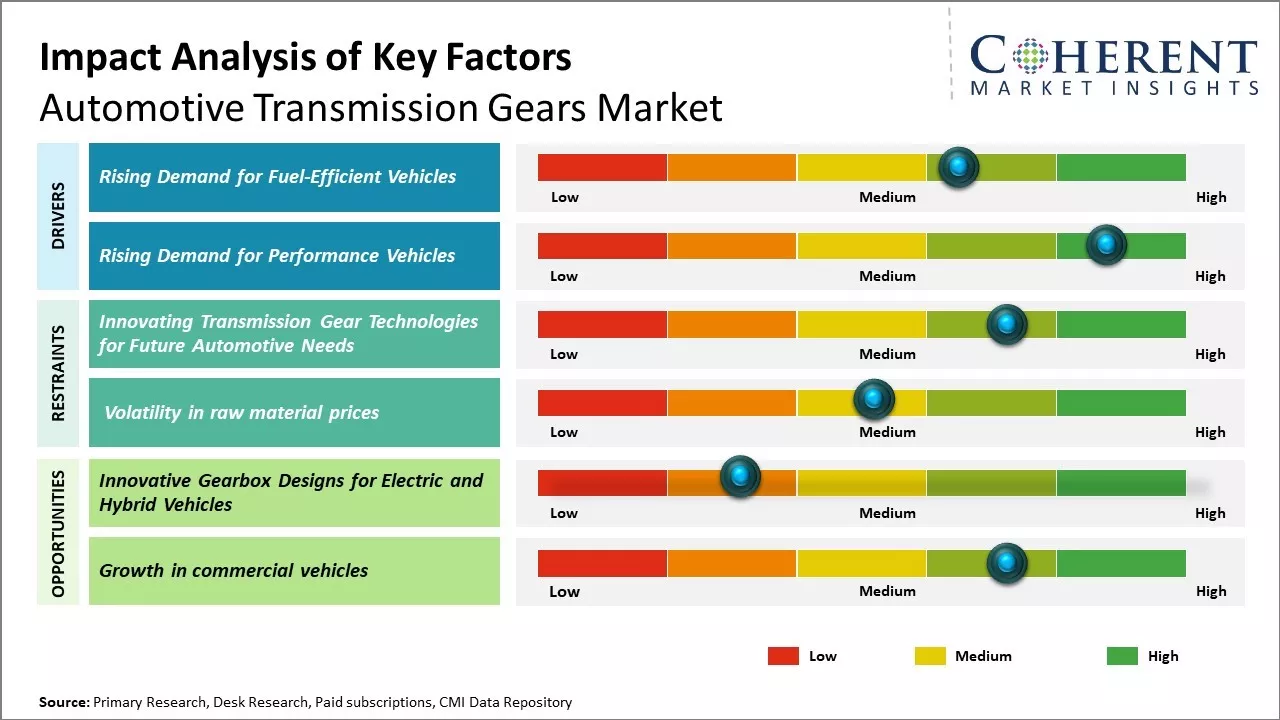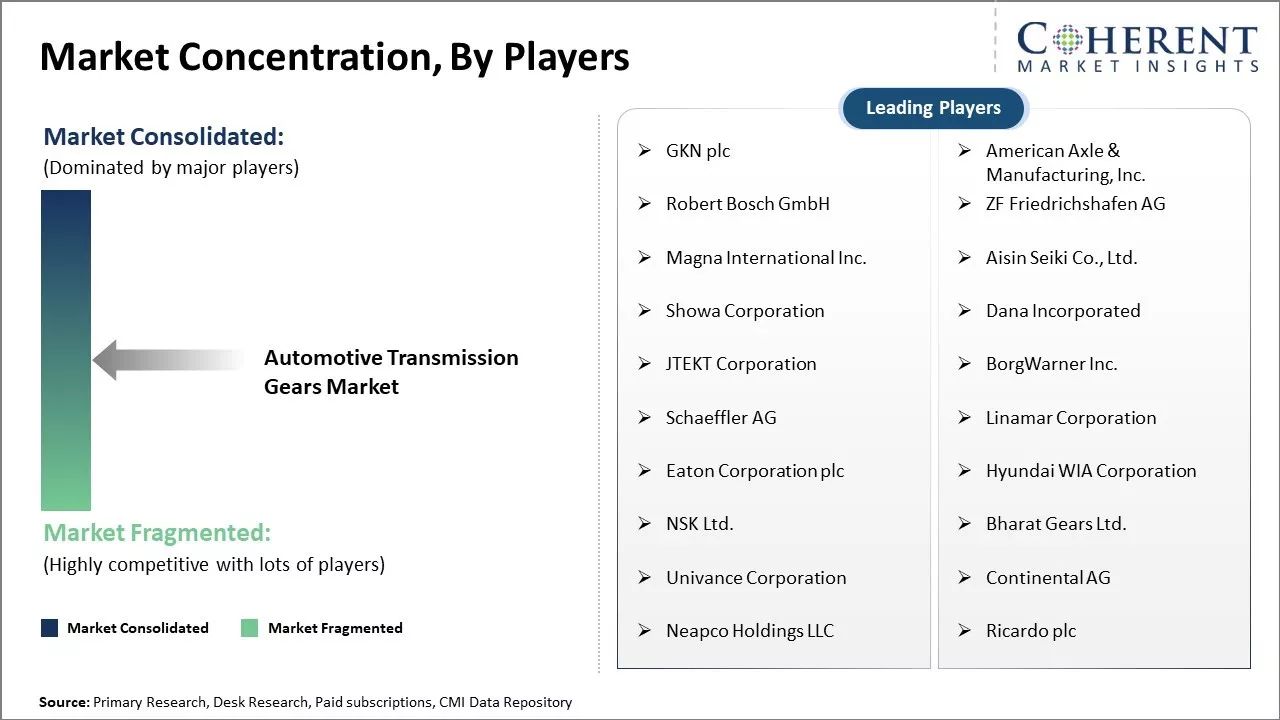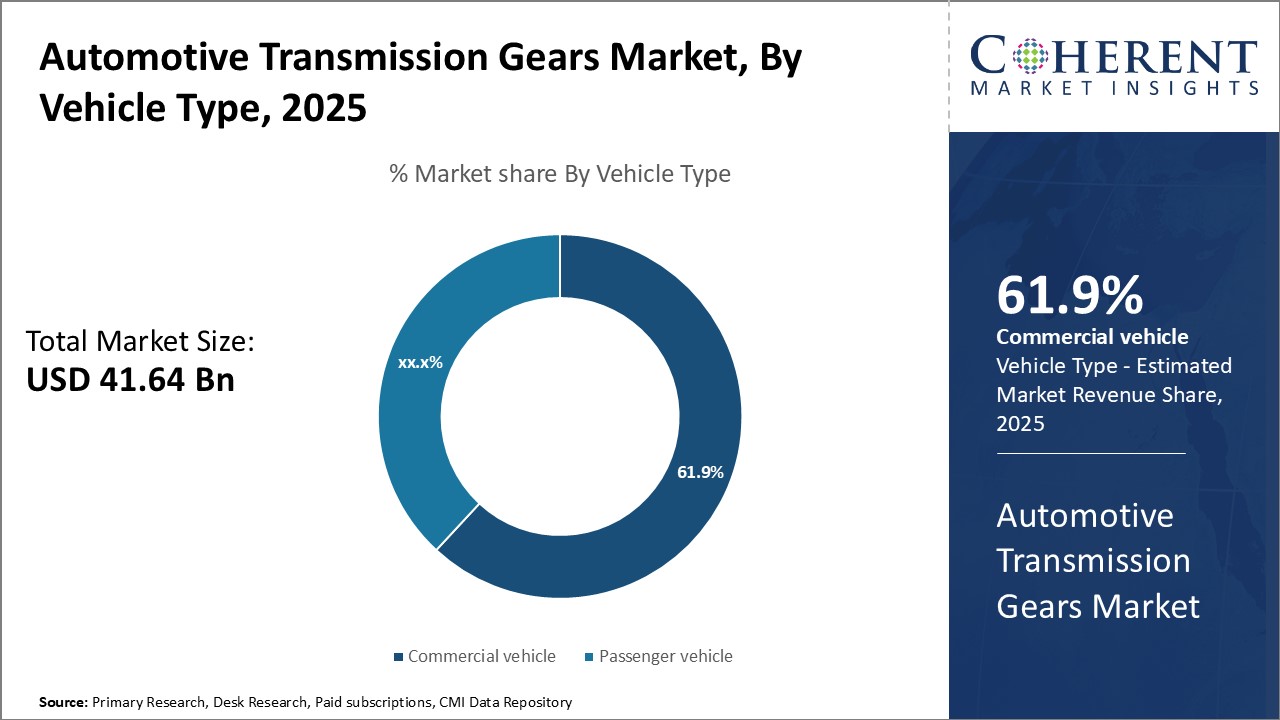The Automotive Transmission Gears Market is estimated to be valued at US$ 41.64 Bn in 2025 and is expected to reach US$ 66.47 Bn by 2032, growing at a compound annual growth rate (CAGR) of 6.9% from 2025 to 2032.

Discover market dynamics shaping the industry: Request sample copy
The automotive transmission gears market is expected to witness a positive growth trend over the forecast period. The increasing demand for fuel-efficient and high-performance vehicles is expected to drive the demand for efficient automatic transmission systems. Along with this, the rising preference for luxury vehicles and SUVs equipped with advanced gear systems is also contributing to the growth of the automotive transmission gears market. However, the increasing adoption of electric vehicles (EVs) which do not require conventional transmission systems is expected to pose a challenge to the market. With technological advancements, manufacturers are developing novel lightweight materials and complex gear designs to deliver enhanced efficiency. This is further expected to offer lucrative opportunities for the market in the coming years.

Get actionable strategies to beat competition: Request sample copy
Market Drivers: Rising Demand for Fuel-Efficient Vehicles
The rising costs of fuel is a major concern for the consumers globally. With fuel prices continuing to fluctuate unpredictably in most parts of the world, people are demanding vehicles which can run economically and help lower their expenses. This is leading automakers to focus more on improving the fuel-efficiency of vehicles without compromising on performance. Transmission systems play a crucial role in this regard as they help in delivering optimal fuel economy. Automakers are constantly upgrading transmission systems with advanced technologies like continuously variable transmissions (CVT), dual-clutch transmissions, and automatic transmissions which improve transmission efficiency. Such fuel-efficient transmissions allow engines to run at optimal rpm for different driving conditions. This is reducing dependency on traditional manual transmissions and driving demand for transmission gears used in advanced automated transmissions. We expect OEMs to further step up their efforts in developing cutting-edge transmissions to comply with stringent fuel-efficiency and emission norms.
Market Drivers: Rising Demand for Performance Vehicles
While economic considerations remain important for majority of buyers, there is a significant consumer base looking for improved driving dynamics and performance in their vehicles. Automakers are catering to these performance enthusiasts by introducing high-performance versions of their mainstream models or dedicated performance-oriented brands. Vehicles with powerful engines require transmissions capable of efficiently handling higher torque loads without comprising shift quality or durability. This is generating demand for special low-weight transmission components, particularly gears made of advanced heat-treated alloys. Such high-performance transmission gears allow reliable transfer of high engine power through precise gear shifts. Manufacturers are also offering transmissions with customized gear ratios optimized for acceleration and top speed. Dual-clutch transmissions are widely being used in performance-focused models for their ability to deliver lightning-quick gear changes. Growing sales of luxury and sports vehicles will further drive requirement of robust transmission systems with optimized gears in the coming years.
Key Takeaways of Analyst:
The global automotive transmission gears market is expected to witness steady growth over the next decade. Increasing demand for passenger vehicles coupled with preference for automatic transmission variants will drive demand for gears. Stringent emission norms worldwide are prompting automakers to adopt more fuel-efficient automatic transmissions. This will increase the usage of gears per vehicle over the forecast period. However, growing demand for electric vehicles may hamper gear demand to some extent as EVs require fewer mechanical components. Additionally, rising raw material prices pose a major challenge for gear manufacturers.
The Asia Pacific region, led by China and India, dominates the current automotive transmission gears landscape owing to the large automotive production bases in these countries. Both nations are witnessing increased demand for private vehicles from a burgeoning middle class. North America and Europe will continue to present consistent opportunities due to the presence of major automakers and transmission gear manufacturers. Meanwhile, the market is expected to expand rapidly in developing economies of Latin America and the Middle East & Africa as vehicle ownership increases in these regions.
Efforts by gear manufacturers to develop advanced materials, improve design, and integrate technologies like additive manufacturing will drive innovation. Adoption of more sophisticated multi-speed automated manual transmissions will push the need for wider gear portfolios.
Market Challenges: Innovating Transmission Gear Technologies for Future Automotive Needs
The automotive transmission gears market faces various technological challenges. With demand for fuel efficient and electric vehicles rising, traditional automatic and manual transmission gear technologies need innovation. Manufacturers need to develop lighter yet stronger gear materials that can endure high speeds and torque levels. This requires significant R&D investments as current gear designs need enhancement to meet future emission and performance standards.
Market Opportunities: Innovative Gearbox Designs for Electric and Hybrid Vehicles
The growing electric vehicles market presents a major opportunity. As EVs use fewer mechanical transmission parts than conventional vehicles, they allow for novel gearbox designs. Manufacturers can focus on developing innovative electric motor integrated gearing systems. There is also scope for customized gearing technologies for hybrid powertrains. Advanced 3D printing offers potential to produce complex, customized transmission gearsets at lower costs.

Discover high revenue pocket segments and roadmap to it: Request sample copy
Insights By, Vehicle Type- Commercial Vehicles' Higher Transmission Needs Fuel Their Segment Dominance
In terms of Vehicle Type, commercial vehicles contribute the highest share of the automotive transmission gears market due to their higher transmission requirements. Commercial vehicles generally handle heavier loads and endure more stressful driving cycles than passenger cars. This translates to commercial vehicle transmissions being subjected to greater stresses on a regular basis. As a result, their transmission components like gears require increased durability, load-carrying capacity and reliability in order withstand the punishing operating conditions. Compared to passenger car transmission gears, commercial vehicle gears are engineered to more stringent specifications that can tolerate high torque loads repeatedly. This focus on robustness and duty-cycle performance gives commercial vehicle transmission gears an edge over others in terms of demand.
Insights By, Gear Type- Planetary Gears' Robustness & Efficiency Drive Their Leading Share
In terms of Gear Type, Planetary gears contribute the highest share of the market owing to their robustness and efficiency. Planetary gears have the ability to handle higher torque loads compared to other gear types due to their unique gear arrangement that distributes force across multiple planet gears. Their compact size also allows them to be used effectively in applications where space is limited. Moreover, planetary gears offer higher efficiency than rival gears since all of the planet gears are continuously in mesh with the sun and ring gears, eliminating inefficiencies from gears swinging in and out of engagement. This robustness and efficiency make planetary gears well-suited for heavy-duty, high-torque applications like differentials and transmissions in commercial vehicles.
Insights By, Application - Differentials' Core Responsibility Drives Their Leading Consumption
In terms of Application, differentials contribute the highest share of the automotive transmission gears market owing to their critical powertrain function. Differentials are responsible for allowing the driveshaft or propeller shaft to transmit drive torque even as the wheels rotate at different speeds during turning. This core function of permitting each wheel to rotate at different speeds while turning makes differentials an indispensable part of any vehicle's transmission system. Compared to applications like transmissions and steering that can utilize alternate component types, differentials demand dedicated gearing designs to fulfill their specialized role. Their singular importance in enabling cornering ability and torque distribution results in a continuous need for differential gears across all vehicle segments and models. This prominence of their application role is a key driver of differentials dominating gear consumption.

Need a Different Region or Segment? Customize now
North America has established itself as the dominant region in the global automotive transmission gears market. The large-scale automotive manufacturing presence along with high vehicle ownership rates across countries like the US and Canada have created sustained demand for transmission gears over the years. Additionally, the preference of consumers in this region has gravitated towards automatic and automated manual transmissions equipped vehicles which utilize more sophisticated gear systems, thus further boosting gear requirements. Leading global transmission giants have set up manufacturing plants as well as research centers in North America in order to leverage the expertise available and cater to the needs of domestic automakers more efficiently.
Central and Eastern Europe has emerged as the fastest growing region for the automotive transmission gears market recently. Countries like Poland, Czech Republic, Hungary and Romania have witnessed rapid growth in their automotive production capacities fueled by investments from global automakers seeking to set up new manufacturing hubs within Europe. The lower labor and resource costs relative to Western Europe have made the region an attractive destination for mass production of small to mid-sized passenger cars which use transmission gears almost entirely procured from within the region or imported from nearby European nations. To meet the demand from growing vehicle manufacturing, many global gear suppliers have either set up regional headquarters or new plants in Central and Eastern European countries, enabling cost effective and timely delivery to automakers. The region also actively promotes its automotive industry through export opportunities in developed auto markets worldwide.
Automotive Transmission Gears Market Report Coverage
| Report Coverage | Details | ||
|---|---|---|---|
| Base Year: | 2024 | Market Size in 2025: | USD 41.64 Bn |
| Historical Data for: | 2020 To 2024 | Forecast Period: | 2025 To 2032 |
| Forecast Period 2025 to 2032 CAGR: | 6.9% | 2032 Value Projection: | USD 66.47 Bn |
| Geographies covered: |
|
||
| Segments covered: |
|
||
| Companies covered: |
GKN plc , American Axle & Manufacturing, Inc. , Robert Bosch GmbH , ZF Friedrichshafen AG , Magna International Inc. , Aisin Seiki Co., Ltd. , Showa Corporation , Dana Incorporated , JTEKT Corporation , BorgWarner Inc. , Schaeffler AG , Linamar Corporation, Eaton Corporation plc , Hyundai WIA Corporation , NSK Ltd. , Bharat Gears Ltd. , Univance Corporation , Continental AG , Neapco Holdings LLC , Ricardo plc |
||
| Growth Drivers: |
|
||
| Restraints & Challenges: |
|
||
Uncover macros and micros vetted on 75+ parameters: Get instant access to report
*Definition: The automotive transmission gears market consists of companies that manufacture gears used in vehicle transmission systems. Transmission gears transfer power from the engine to the drive axles and wheels, allowing the vehicle to move. The main types of gears included in this market are transmission gears, differential gears, and transfer case gears. Key manufacturers produce constantly optimized gear products to improve fuel efficiency and vehicle performance for applications in passenger cars, commercial vehicles, and off-highway vehicles.
Share
Share
About Author
Gautam Mahajan is a Research Consultant with 5+ years of experience in market research and consulting. He excels in analyzing market engineering, market trends, competitive landscapes, and technological developments. He specializes in both primary and secondary research, as well as strategic consulting across diverse sectors.
Missing comfort of reading report in your local language? Find your preferred language :
Transform your Strategy with Exclusive Trending Reports :
Frequently Asked Questions
Joining thousands of companies around the world committed to making the Excellent Business Solutions.
View All Our Clients
US Reciprocal Tax Impact Analysis On Automotive Transmission Gears Market
Stay updated on tariff changes with expert insights and timely information